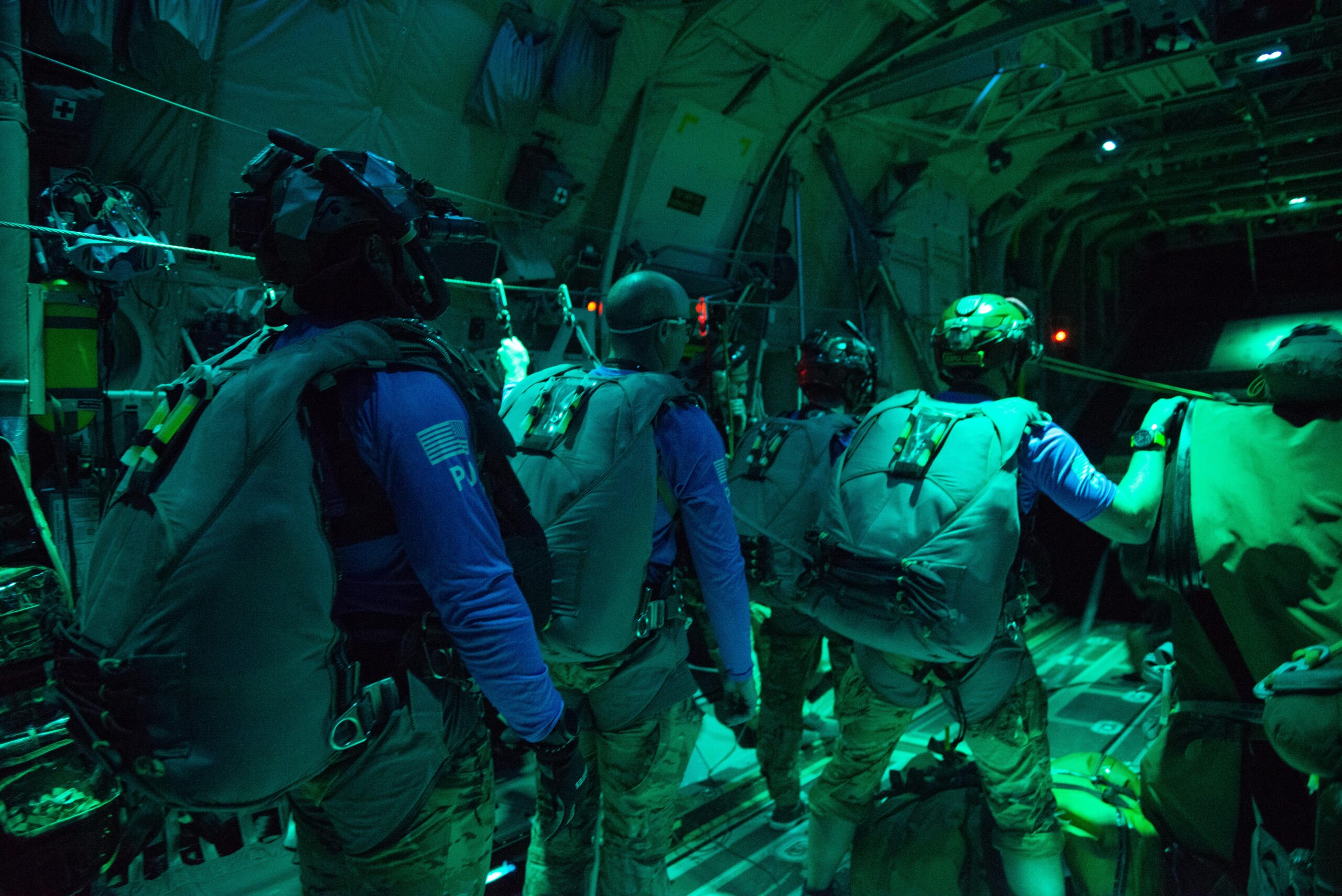

As an HC-130 fired off flares to light up the black ocean below, a team of four California Air National Guard Pararescuemen, or PJs, parachuted into the Pacific Ocean July 8 on a daring nighttime mission to reach a badly injured crew member of a Costa Rican fishing boat.
Far from any support or retreat, the PJs jumped 750 miles off the coast of Costa Rica, after an all-day flight from Moffett Air National Guard Base outside San Jose, California, home of the Air Guard’s 129th Wing.
The team was responding to a call for help sent the day before from a Costa Rican fishing boat, the Victoria G. A crew member had been struck in the head by a metal pole when a pulley snapped. The fisherman sustained head lacerations. By the time the Californians arrived overhead, the man was in and out of consciousness and vomiting, dire symptoms of a worsening head injury, the 129th Wing said in a release.
“The seriousness of the young patient’s injuries was in the back of our minds the whole time we were weighing the risks of jumping a team in at night into such a remote location,” said Tech. Sgt. Tammer Barkouki, a pararescueman and jump master with the 131st Rescue Squadron. “We had to assume his injuries were possibly life-threatening or could lead to permanent neurological damage if left untreated.”
A Cry For Help 3,000 Miles Away
Just getting within range of the boat would take a full day’s flight. Costa Rica is 3,000 miles from San Jose, farther than Miami, Florida, or Augusta, Maine. An HC-130 crew from the 129th and a four-man PJ team started the long flight on the morning of July 8. The crew also included tactical aircraft maintenance specialist Tech. Sgt. Jose Arceo as a translator for radio communications with the boat’s crew, the 129th said.
Though HC-130s are primarily used as tankers to refuel HH-60 rescue helicopters, their crews train regularly to support long-distance jump missions. Pictures and video of the mission released by the Guard show the PJs filled much of the HC-130s cargo bay with parachutes, medical and ocean survival gear, and two specially packaged rubber boats that PJs developed in the 1980s for mid-ocean rescue missions. The boats are dropped by parachute and, once in the water, PJs inflate them using a scuba tank.

Mid-ocean jumps are among the rarest and most complicated missions that Air Force and Air National Guard rescue units train for. A 2020 article published in the Journal of Special Operations Medicine counted just 12 missions since 2010 in which PJs parachuted into the middle of an ocean for a rescue. Those missions ranged from 600 to 1700 nautical miles out to sea, the Journal said. Generally, Air Force or Air Guard teams are only dispatched on such missions when emergencies occur beyond the range of Coast Guard helicopters or other shore-based help, and when no other ships are nearby to assist.
To reach the Costa Rican sailor, the California team flew first to Mexico City before continuing towards the boat.
“We were trying to get detailed information on how critical the patient was and that would determine how much risk we would take, and as the sun set and it went into darkness, it elevates our risk jumping in the ocean,” said Tech. Sgt. Gershom Rosengarten, a pararescueman with the 131st Rescue Squadron.
In the Guard’s video of the jump, the team deploys from the rear of the HC-130 into a black night, with only the lights of the ship visible below. The video shows PJs jumping seconds after the boat package is deployed, each wearing heavy swim fins, other water gear, and a cumbersome equipment bundle. Though PJs regularly train to do freefall jumps into water landings, the heavily laden, fin-wearing team appears to have opted to use static line-activated parachutes, similar to traditional paratrooper equipment used by the Army. The static line-activated parachutes open immediately as a jumper leaves the plane, allowing the PJs to exit in a “sitting” position, a lower-risk technique when a jumper is loaded with heavy gear. Static line deployments also allow the PJs to jump from a lower altitude making their landings more accurate — a result that could have life-or-death consequences far from shore at night.
Once aboard the fishing vessel, the Guard said, the PJs spent several days monitoring and treating the fisherman’s neurological state. Both the patient and the PJ team eventually transferred to a larger ship, the Royal Midori, which steamed the group into Puntarenas, Costa Rica, where the patient was transferred to a hospital
“He was in much better condition than 4 days prior,” said Rosengarten. “Each day that we helped him, there was a noticeable improvement.”
“It is a great feeling to know that we could aid an injured person over 2,000 miles away and help bring him home,” said Barkouki.
The Guard said the mission represented the 129th Wing’s 1158th life saved.
